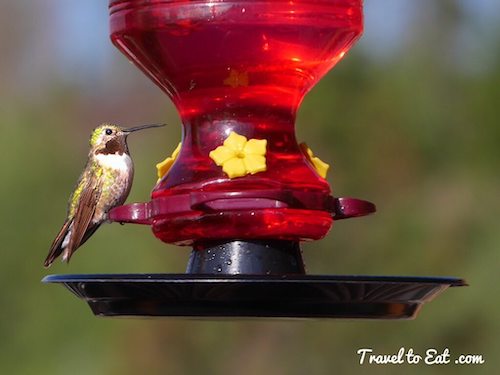
We traveled to Grand Lake Colorado and stayed at The Gateway Inn for my niece’s wedding. On the patio, they had a colony of about 10 ruby-throated Hummingbirds, chirping and chasing each other between the four feeders. I just love hummingbirds, they are so small, so quick and so colorful, a lovely addition to any garden. There are between 325 and 340 species of hummingbird, depending on taxonomic viewpoint, divided into two subfamilies, the hermits (subfamily Phaethornithinae, 34 species in six genera), and the typical hummingbirds (subfamily Trochilinae, all the others). Most hummingbirds of the U.S. and Canada migrate south in fall to spend winter in Mexico or Central America. Ruby-throated hummingbirds migrate from as far north as Ontario south to Central America and Mexico via direct crossings of the Gulf of Mexico or coastal Texas. White granulated sugar is the best sweetener to use in hummingbird feeders. A ratio of 1 part sugar to 4 parts water (25%) is a common recipe, although hummingbirds will defend feeders more aggressively when sugar content is at 35%, indicating preference for nectar with higher sweetness and sugar content. The ruby-throated Hummingbird is by far the most common species that breeds in the eastern half of North America, although most states have sporadic sightings. They are hard to photograph but I managed to get these photos.




The Taino Native American people were the first people to meet Columbus in 1492. The Hummingbird is the symbol of the spreader of life on the Earth. It also symbolizes the rebirth of the Taino Indian Nation of the Caribbean and Florida. They also call their Warriors, Colibri Warriors (Hummingbird Warriors), as the Hummingbird is very peaceful but it protects it own homeland with the heart of an eagle. Their history tells us the small Hummingbirds were at one time small flies that Agueybaba the Sun Father transformed one day into little birds.


Adult male ruby-throated hummingbirds have pointed rectrices (tail feathers) that are all dark with no white tips; the tail is forked. However, young males, like females of any age, have white tips on the outer three rectrices on each side; each feather is rounded and the tail is fan-shaped. Young males however, are only seen in the spring. Courtship is apparently very brief, if it exists at all, and once mated the female raises the young alone. Two white, pea-sized eggs are laid two or three days apart, which the female will incubate from 60 to 80 percent of the day for 12-16 days. Reports of the duration of the nestling phase vary from 14 to 31 days, the wide range possibly varying with the availability of food; 18-23 days is normal.


Ruby-throated hummingbirds winter in Mexico and Central America. To get there from their North American breeding grounds some birds embark on a marathon, nonstop flight across the Gulf of Mexico. They may double their weight in preparation for this grueling journey.


The Audubon Society, National Geographic, and Wikipedia all claim that the range of Ruby Throated Hummingbirds (Archilochus colubris) is in the eastern United States. However, these photos in Grand Lakes Colorado, my mother’s feeders in Denver, my own feeders in Las Vegas with at least 10 hummingbirds and friends in California all prove that these maps are completely wrong. Ruby Throated Hummingbirds seem to exist all over the United States, although they do seem to disappear in winter.
[mappress mapid=”47″]
References:
Hummingbirds: http://www.hummingbirds.net/
NatGeo: http://animals.nationalgeographic.com/animals/birds/ruby-throat-hummingbird/
Audubon: http://birds.audubon.org/birds/ruby-throated-hummingbird

